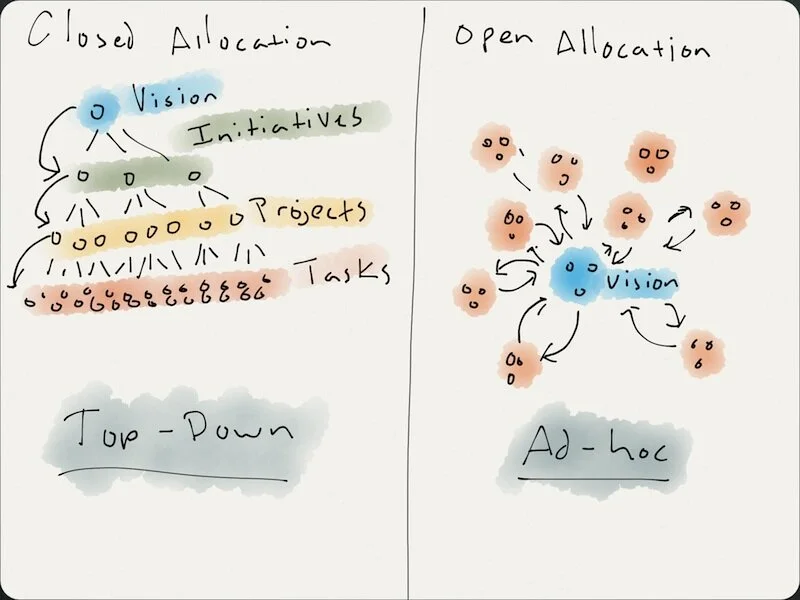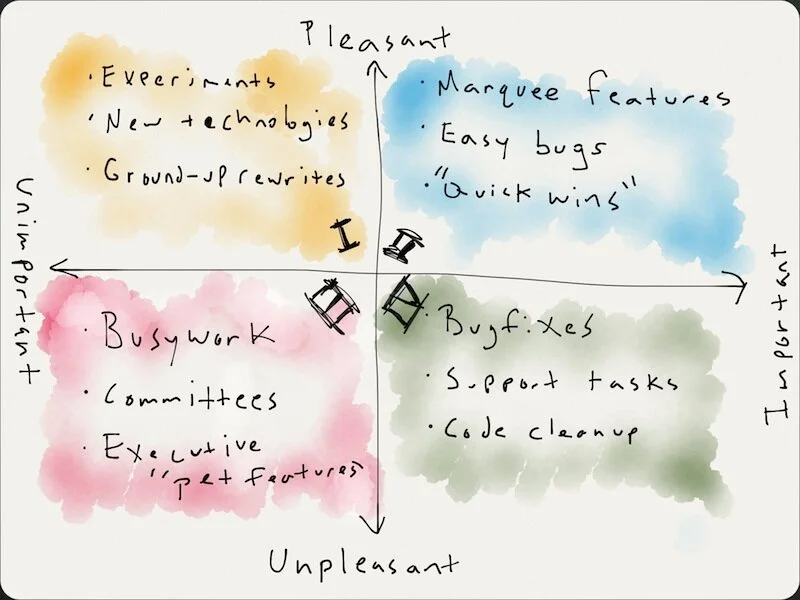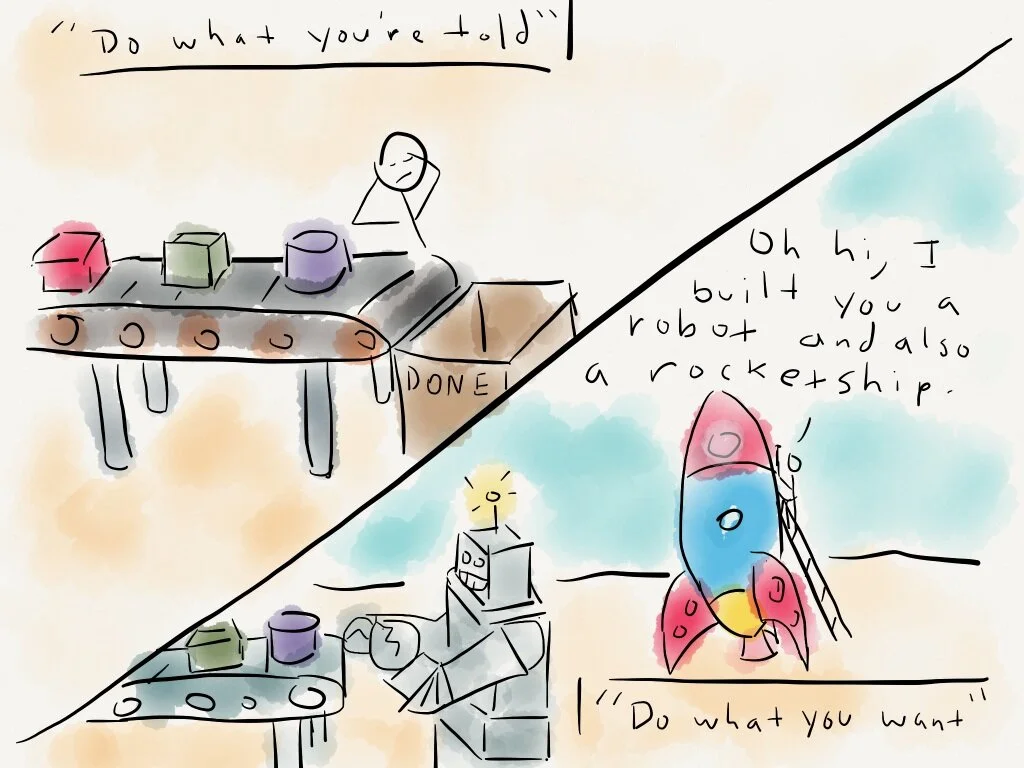Closed allocation: A failed system of control
A couple of years ago, I found myself boxed into a corner. I wanted to become a developer, but my workplace kept pigeonholing me into a management role, where I would break down (very important!) tasks to give to our other, more experienced developers.
Thanks to an intervention by a brutally honest friend, I found the strength to basically quit one (very important!) job internally to become a developer. I got to stay at the company, but took on an entirely new role, letting the old one languish and die. This was very scary at the time.
Then, six months later, my prior (very important!) position was eliminated and everyone else performing it was laid off. But I had left that role to become part of a central, truly indispensable team that was regarded as the engine of innovation for the company.
All the stuff that the organization told us was critical was actually of no long-term benefit, even harmful, to the company. The worst part is that we, the performers of those jobs, knew this, but couldn’t do anything to change it.
This is the curse of closed allocation.
The article: You should read it
A couple of months ago, I read an article by Michael Church that gave voice to many of my recent thoughts on company culture. It challenged me, and although I disagreed with some of its prescriptions, I believe it’s well worth your time.
It also taught me some labels for a critical distinction in corporate cultures: open allocation vs. closed allocation.
These terms help define a unified theory that pulls together the differences between older-industrial-revolution-era cultures (think Goldman Sachs or the military) and post-internet-era cultures (such as Netflix, Valve, or Github).
Open vs. closed allocation: what’s the difference?
Closed allocation is the traditional system of having organizational leaders translate a company’s mission into a specific set of priorities and projects, then creating a management layer to break these down into tasks, which are then delegated to employees.
Open allocation is a radically different system of having organizational leaders communicate the company’s mission to all employees, skipping the management layer, and offering the employees complete self-direction and self-organization.
Closed allocation relies on a scarcity philosophy and zero-sum math. There are so many things to be done, and so few hours. Employees should leave the decision-making to us and perform their tasks quickly and well.
It’s also pretty cynical: I_f people aren’t told what to do, they’ll do the wrong thing. If they aren’t monitored and prodded, they won’t do anything at all._
Open allocation systems operate on an abundance mindset and exponential math: If people buy into our goals and apply their passion and talent, they’ll uncover paths to success that we can’t even envision.
Open allocation is the Trust portion of the culture triangle carried out to its maximum. If we entrust our vision to good people, they’ll focus on solving problems that are truly high-value.
What about drudge work? Doesn’t it just pile up?
The number one fear I’ve heard from people regarding open allocation is “but what about the work no one wants to do?”
First, it’s important to break these kinds of work apart.
Michael defines a matrix along two axes: A work’s importance to the business and its pleasantness.
I. Pleasant/Unimportant (R&D) Developers are all too happy to experiment with new techniques and technologies, or to rebuild an existing system from scratch. Google calls this “20% time”, and open allocation shops don’t place a limit on it. While activities in this quadrant don’t appear to have immediate value, letting developers “play” produces incredible long-term value for businesses. In fact, nearly every major innovation from Google in the last 5 years has been from this “20% time”.
II. Pleasant/Important (High-visibility projects) Shipping new features is fun, and there are plenty of intrinsic organizational rewards. Knocking out a bunch of small, quick bugs or features carries an immediate, visceral reward. Both open and closed allocation systems do this well.
III. Unpleasant/Unimportant (Junk pile) Developers, by default, will avoid unpleasant tasks that add no value to the business. It’s why they hate meetings like vampires hate sunlight. (Some developers hate sunlight too, but this is unrelated.) A huge amount of time in closed allocation systems is wasted here, and it’s virtually eliminated in open allocation.
IV. Unpleasant/Important (Maintenance) I’ve sometimes heard the term “maintenance developer” used as a pejorative. But developers doing “maintenance” are the unsung heroes. And here we are. This is what people fear losing by moving to open allocation.
First, let me attempt to unburden you of the belief that this work gets done or done well in a closed-allocation system. Most likely, this work is being picked at and pushed around like the steamed carrots on a 4-year-old’s dinner plate.
And this is where Michael and I part ways. His advice is to incentivize, which is yet another tactic that has been proven to have the opposite of its intended effect. (You’ve probably already seen this video, but it’s a great, concise explanation of why.)
What I’ve noticed is that if you have a collaborative team, the unpleasant tasks carry their own intrinsic rewards within a team. The deepest desire of many of my favorite developers is to make their work and that of other developers easier and less tedious.
It’s only in closed allocation systems that developers quietly accept work that comes to them on a conveyer belt. In open allocation, developers will automate the work that comes in via conveyer belt so they can go do something more interesting.
Competition between ideas, not people
When what you work on is not your choice, the only influence you have is to try and compete to get better work. People compete to avoid doomed, unpleasant, or unimportant projects and to get assigned to high-visibility, high-impact work.
In fact, management often views this as a valid mechanism of control, and actively fosters competition between teams or team members.
In a closed allocation system, people compete for the right to work on good ideas, while in an open allocation system, ideas compete for the right to have people work on them.
Competitive environments add an unnecessary layer of stress and interpersonal discord among team members. This leads to burnout, causes good people to leave, and inspires people to put their energy into “managing perceptions” rather than producing excellent work.
My experience is that the only environments that create lasting value foster a collaborative environment where the reward structure is tied to making your team better, rather than being better than the rest of the team.
Either way, a company will grind something up in the course of making progress. But it’s up to leadership to decide whether ideas or people are the grist for that mill. And grinding people instead of ideas turns out worse products. You’d think this would be an easy decision, right?
If open allocation is so great, why are so few doing it?
Closed allocation is the default for almost all companies. If open allocation is so superior, why hasn’t it immediately become the go-to organizational structure for new companies?
First off, almost every company starts with open allocation. It’s the DNA of a “startup” or “small business”. But amazingly, no one seems to notice as the open allocation inherent in a 5-person company starts closing up, management starts getting injected to wrangle the chaos, and employees start losing their voices and autonomy.
But the question stands: Why is closed allocation the dominant philosophy?
It’s how you manage people who don’t want to be there. If someone’s job is to sew a boot to its sole at a rate of 500 per day for minimum wage, it’s conventional wisdom that they require external motivation to stay on task at maximum efficiency (although this is debatable).
People are conditioned for closed allocation. Public schools, churches, and most areas of modern Western society condition people that how their time is spent is ultimately decided by those “in charge”.
Change is scary. Every part of every organization is highly optimized, even dependent, on closed allocation systems. Most people in closed allocation systems fear the increased responsibility of an open system, even if they’d excel in it.
Lots of other reasons. It’s a mechanism that provides stakeholders with a feeling of control over chaos. It protects people who make decisions, even if they themselves are unneeded. (When have you ever heard of a management team opting to lay itself off?) Maybe the company is hiding from the fact that it has no compelling vision. But ultimately, the fact is that everyone in a closed-allocation system eventually buys into it, even if they complain about it.
But how do I know who to fire?
This is the other question I’ve heard about open allocation. How do you know which employees are valuable and which are harmful without targets, measurements, or stack ranking? Michael Church’s article covers it well, but in short: you’ll fire fewer than you’d think. People will find more ways to contribute in an open allocation system than if they’re pigeonholed into a rigidly-defined role.
Open allocation systems only let go of the people who are so political, passive aggressive, or poorly-performing as to cause a serious morale drag amongst your other team members. It will be obvious who doesn’t fit in your open allocation system, because their team will share a set of concerns and will have tried everything they could think of to make them successful.
Ignoring this can cost you your best people, even your business
At most companies, try to talk about turnover, and you may be shocked to encounter a_ “fingers-in-ears-lalalala-can’t-hear-you”_ level of denial. But this makes sense in closed allocation companies.
To confront how, when, and why employees might exercise their right to leave is to realize that 100% of the control closed allocation offers is an illusion. Each human being has a limited tolerance for being treated like a puppet or a cog. And at some point, they’ll run out of tolerance and find a reason to quit or be fired.
Losing key employees is the most expensive thing that can happen a company. Finding, training, and growing talent for knowledge work is ridiculously expensive. That’s to say nothing of the fact that at smaller, wobbly-kneed startups, high turnover could sink the company.
By the time you actually start experiencing turnover, it’s already so late in the cultural decline that no one seems to know what to do. So, executives tend to go into deep denial.
I am not aware of any studies about the difference in turnover between open- and closed-allocation shops, but Github has not lost an employee yet (although they have fired about a half dozen of their 150+). I can promise that when numbers on open allocation (non-) turnover are finally run, a bunch of MBA-types are going to start taking notice.
Can’t I just use some components of open allocation?
Short answer: No.
Much like any ground-up rethink of an existing system (such as the Getting Things Done system or the Paleo diet), you can’t sample pieces to see how they work individually. It’s a package deal.
I’ve been inside multiple companies that decided to “try out” these open allocation systems. And I can promise what will happen is company leaders will quickly realize that almost every person in the building is dependent on this closed allocation ecosystem, and go back to what was comfortable. Every time.
In fact, I can’t point to a case study of a company ever converting, in part or in full, to open allocation from closed allocation. I’m not saying it’s impossible, but I can’t advocate it. What I am advocating is that high-performing people start selecting themselves into open allocation environments, and as they found companies, to build and protect an open allocation system within them.
I’m stuck in a closed allocation system, what now?
Unless you work in a 5-person startup or the government, chances are that your workplace is someplace in between these two extremes, with a strong bias toward closed allocation.
First off, you should know that you have more room than you think if you throw some elbows around and redefine your job. If you’ll take a bit of risk, you’ll find more ability to define your own job than you previously thought. If you assert yourself as someone who understands your job well, and that you understand the company’s goals, you’ll find yourself with more input into the kind of projects you work on and they way you do them.
The sad truth is that ultimately, if you are a high performer, you will find yourself out of patience with the system you’re in. If you’re not careful, you’ll let this frustration drive you into the arms of another closed-allocation system, unaware that the cycle is simply beginning anew.
But I hope you’ll break the cycle and select for open allocation cultures (or go start one yourself), rather than reacting by simply job-hopping.
Who should switch to open allocation?
Imagine your employees, highly engaged, working on the exact thing that rings their bell, finding novel solutions to your most important problems, and pushing your organization closer to its ultimate vision, automatically, without needing to oversee every detail.
This is the promise of open allocation. If your organization has a true vision and a culture of honest feedback, you stand to benefit greatly from this style of management. If you lack either… well, open allocation might not be a fit.
But if you run a shop that you’re confident has vision and feedback, you may wonder if it’s possible to try at all. You could create this type of team that reports directly to the CEO and that has full autonomy, but not without majorly disrupting the rest of the organization, which I’ve seen inspire jealousy and backbiting. It’s treacherous territory, but if you’re bold enough to try it, you’ll discover that you can attract and keep the kind of talent that does great work autonomously.
Lastly, if you run a closed-allocation shop, make note of this warning: Open allocation shops are so fast, so nimble, and have so much energy that if a competitor runs one, they’ll someday be the Muhammad Ali to your Sonny Liston.
You get to choose which to be, but make no mistake, you will be one or the other.


